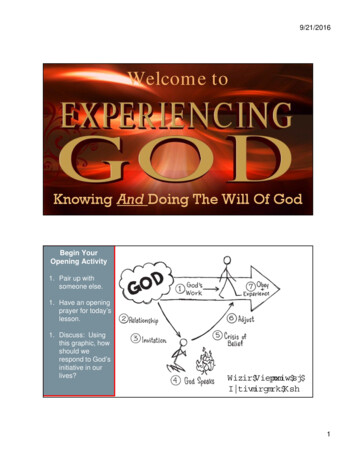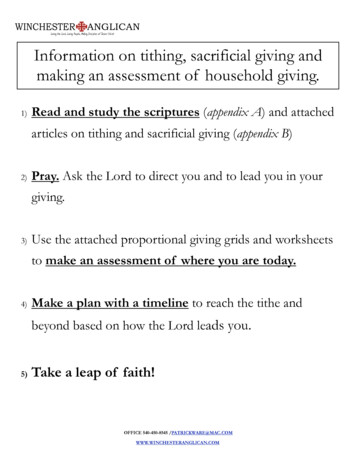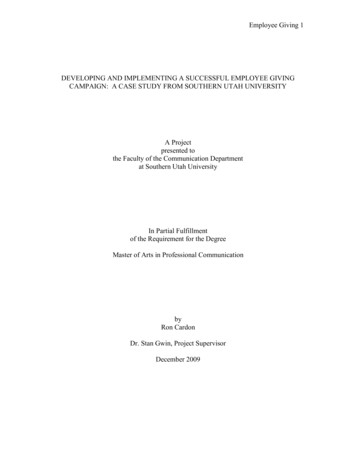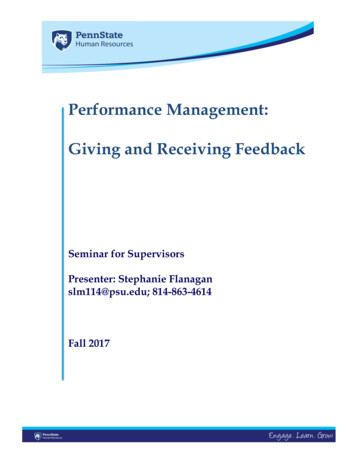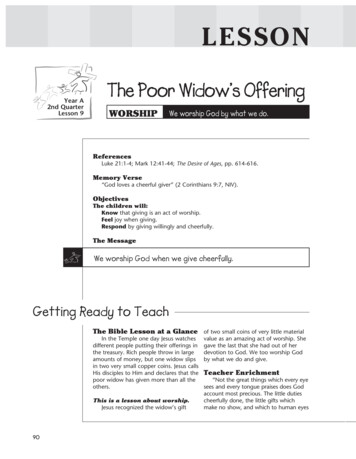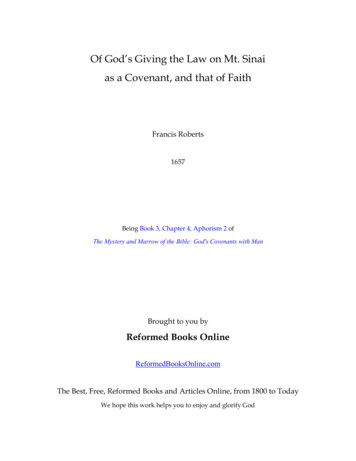
Transcription
Of God’s Giving the Law on Mt. Sinaias a Covenant, and that of FaithFrancis Roberts1657Being Book 3, Chapter 4, Aphorism 2 ofThe Mystery and Marrow of the Bible: God's Covenants with ManBrought to you byReformed Books OnlineReformedBooksOnline.comThe Best, Free, Reformed Books and Articles Online, from 1800 to TodayWe hope this work helps you to enjoy and glorify God
Table of ContentsIntroduction3Extended Outline9Of God’s Giving the Law on Mt. Sinai as a Covenant, and that of Faith27I. The Mosaic Law was a Covenant29II. What Law was Given as a Covenant at Mt. Sinai?33III. Of What Sort and Manner of Covenant was this Mosaic Law?351st Opinion – A Covenant of Works362nd Opinion – Mixed: A Covenant of Grace and of Works473rd Opinion – A Subservient Covenant534th Opinion – A Covenant of Grace63(I) Its Unique Administration63(II) The Suitability of its Administration65(III) Reasons why it was a Covenant of Grace67(IV) Objections Answered781. Jesus Seems not to be Promised in it782. Justification by Faith was not Revealed in it80Gal. 3:12 ‘The Law is not of faith.’3. If Faith be Commanded, Then we are Justified by Works844. It is Opposed to the New Covenant and can be Broken85Jer. 31:31-32; Heb. 8:8-101
5. The Law was given by Moses, grace and truth by Jesus Christ86John 1:17; Rom. 6:14-156. Paul opposes the Mosaic Law to the Promise89Gal. 3:18; Gal. 4:24-26; 2 Cor. 3:6-97. ‘The man which does those things, shall live by them.’79Lev. 18:5; Deut. 27:26IV. Why the Lord Gave this Covenant of Faith by Moses to Israel102V. Inferences103(I) God’s giving of the Law to Israel was an Act of Singular Grace103(II) The Mosaic Covenant Revealed Christ More than any Covenant Before it105(III) Israel was Saved by Christ under the Mosaic Covenant as in the N.T.110(IV) The Mosaic Covenant did not Intend Justification by Works113(V) The Mosaic Law was Israel’s Gospel116(VI) Many Errors about the Mosaic Covenant may be Condemned116(VII) The Mosaic Covenant Must be Looked Upon with an Evangelical Eye117Text in [brackets] is the editor’s. This contemporary edition was edited from the public domain text at EarlyEnglish Books Online. Updated English, punctuation, capitalization, formatting and minimal stylistic changeshave been made in order to make this work easier to read, while always seeking to preserve the original intent ofthe author. For any questions, see the original text and also compare this facsimile. Thanks to Bobby Phillips fortranslating several Latin quotations. The specific version of this work is licensed under the very sharing-friendly:Creative Commons Attribution-NoDerivatives 4.0 International License 2016Please share this work in any godly way, shape, or form desired.2
IntroductionRev. Travis Fentiman1The English puritan, Francis Roberts (1609-1675),2 wrote the 1,700 page magnum opus onCovenant theology: The Mystery and Marrow of the Bible: God’s Covenant with Man (London, 1657).Roberts understood covenant theology to comprise the marrow, or heart, of the Bible. Of specialinterest today, in light of revived and ongoing debates about how God’s covenant with Mosesmay or may not be a covenant of works, is Roberts’ 300 page treatment of the Mosaic Law, beingperhaps the most detailed and full, scriptural and theological discussion of the Mosaic Covenantfrom the Reformation and Puritan eras. The most relevant and important section of this largerportion is given here for the first time in a contemporary and easily readable edition.Roberts opens his piece by arguing that the administration revealed through Moses wasnot a bare law only, as many people in his day took it to be (as well as in our own), but was aCovenant of fellowship. In the second section, ‘What Law was Given as a Covenant at Mt. Sinai?’,Roberts is at pains to show that at Mt. Sinai God did not give the moral law only, but also gavethe judicial and ceremonial laws as well. The significance is that the Mosaic Covenant was notcovenant of works of moral law only, simply and merely being a law to live by, but rather was aunion of fellowship between God and Israel upon the larger terms of grace, specifically as theceremonial law came with the provision of an atonement and the civil law showed God’s care forIsrael socially.1 Rev. Fentiman is a Licentiate in the Free Church of Scotland (Continuing) and earned an MDiv. fromGreenville Presbyterian Theological Seminary. He resides in Vermont with his bride and two dear children.2 For a brief, popular introduction to the life of Roberts, see the blog article by R. Andrew Myers, ‘God’sCovenants’. For a fuller, scholarly life of Roberts, see Won Taek Lim, The Covenant Theology of Francis Roberts (2000)pp. 29-37. Most of Roberts’ works are available online at PRDL and EEBO. Two of Roberts’ works have beenreprinted (as of 2016) and can be purchased through Puritan Publications. Several short selections from Roberts’works have been newly edited and can be found at Books and Articles Exclusive to ReformedBooksOnline, which isalso a convenient place to find this document.3
In the third section, ‘Of What Sort and Manner of Covenant was this Mosaic Law?’, Robertsoutlines four views on the Mosaic Covenant that were held by some in his day, namely that theMosaic Covenant was:(1) A straight covenant of works, differing in substance and in the way of salvation fromthe Covenant of Grace, as held by the four, eminent, Dutch, reformed Leiden professors intheir influential textbook of Reformed theology (which is otherwise a standard oforthodoxy), Synopsis of a Pure Theology3 Buy (1625);(2) A Covenant mixed with works and grace, as held by some English predecessors ofRoberts, and probably aimed by him at the influential Dutch Johannes Cocceius’ theory ofcovenant abrogations;4(3) An independent, Subservient Covenant, serving a preparatory purpose to the furtherunfolding of the Covenant of Grace in the New Testament, as delineated by the Scot-born,French theological professor, John Cameron, many of the Amyraldians following, andothers; and(4) That the Mosaic Covenant was ‘in substance’ the Covenant of Grace, uniting both theOld and New Testaments, though it differed in ‘circumstance and manner ofadministration.’ This latter view, according to Roberts, was the majority, Reformed viewof his own day (see also its confessionalization in the Westminster Confession of Faith, 7.6).Roberts spends the major share of his treatise critiquing the first three views. As manyChristians today are of the first opinion, that the Mosaic Law was a covenant of works forsalvation, Roberts’ demonstration otherwise (on pp. 35-46 and 65-77 below) will be of great valueshowing that persons in the Old Testament were saved by grace through faith in Christ, who wasportrayed throughout the Mosaic period in innumerable and diverse ways. Roberts’ refutationof the first three opinions (pp. 36-62) will be helpful in seeing the continuity, in numerous andFor a brief view of the whole book, see Dr. Ryan McGraw’s review on Amazon. For their section on theMosaic Covenant, read Disputation 23, ‘On the Old and New Testament’. Roberts accurately represents theirposition. Their treatment is unfortunately brief and surprisingly unqualified.4 Per Lim, Covenant Theology, p. 23234
marked detail, of God progressively revealing the same Covenant of Grace through the OldTestament, contrary to modern dispensationalism.While some of the particularities of the first three viewpoints are not popularly held today(especially the specific and detailed constructions of Cocceius and Cameron), and hence Robertscannot be said to have had the contemporary paradigms of our last several decades in view, yetthe multitude of his arguments, it will be seen, if they do not apply directly to the contemporarycompeting paradigms, yet put them in the firing range. Roberts’ discussion, even in thesesometimes obscure points, is so full, insightful and instructive, that it cannot fail to be of greathelp in the contemporary discussion.The fourth viewpoint is Roberts’ own, that the Mosaic Covenant is not a covenant of works,but (in his own words) a ‘Covenant of Faith’. This phrase, for Roberts, is synonymous with theCovenant of Grace,5 though emphasizes the necessity of, and prominence given to, faith in God’sCovenant. For the Old Testament administration of the Covenant of Faith, Roberts uses theterminology of ‘Covenant of Promise,’ emphasizing its promissory aspect.For the NewTestament administration of the Covenant of Faith, Roberts uses the term ‘Covenant ofPerformance,’ which emphasizes Christ’s historical performing of his promises to us.Though the Mosaic Covenant is a further unfolding of the Covenant of Grace, theparticular administration of that Covenant, uniquely from all of its other administrations, placedan emphasis on law, the rigor of it, obedience to it and a curse for breaking it (though this lawemphasis did not alter the way of salvation). Roberts’ remarkably insightful and profoundenumeration of these peculiar and Law-glorious manners and circumstances of the Mosaicadministration, with God’s wise reasons for them, is found on pp. 63-67 below.Roberts’ most particular contribution to the understanding of the Mosaic Law is delineatedand argued positively in Opinion 4, Objection 7, Part 3, pp. 94-99 below, in discussing the pivotaltexts: Dt. 27:6 and Lev. 18:5, ‘The man which does those things, shall live by them.’ Roberts arguesagainst the influential John Ball (1585-1640), who took the key texts as only expressing evangelicalobedience, that he who is a doer of the Word, sincerely and continually (though imperfectly) by5See pp. 36, 68, 69 & 89 below for some instances of faith’s interchangeability with grace.5
saving faith, will find life and blessing in doing what God says (Ps. 112:1; Ps. 106:3; Ps. 119:1,2;James 1:25; Rom. 2:7; etc.).Though the Mosaic Covenant, for Roberts, was not a re-offering of the Covenant of Works(which Adam had broken in Eden; we being under its curse), yet the Mosaic administration didhold out the promise of life by the keeping of the law; not that it was intended for the Israelites topursue life through the law, but rather, to show them more acutely that they could not keep it (itrequiring perfect obedience), that life does not come to sinners by the law and to more effectivelydrive them to the offered Savior (this being known in Reformed theology as the First Use of theLaw). Thus the law was not held out as coordinate with, but subordinate to the offer of gracethrough faith in the coming Messiah, who was portrayed in shadows throughout the Mosaicadministration.If there is such a promise of life upon the keeping of the law (though it be unattainable andonly hypothetical), then that makes works the condition of it. These two separate conditionspresent in the Mosaic administration (and in no other administration), of works and faith, wasnot an unexplained peculiarity for Roberts, but was fitting and morally necessary for a specialreason: to show more clearly the work required of us and fulfilled by the sinner’s Surety. Thusboth work and faith are required in salvation: we receiving the perfect doing of Messiah’ work(prefigured in the ceremonial law) through believing (alone).It should be noted that the prominence of the condition of the law that was added to thispeculiar administration of the Covenant of Grace, for Roberts, only had relevance to drivingsinners to salvation and acceptance with God (the primary thing) through the Messiah, and didnot enter into the Israelites’ right to, or continuance in, the promised land of Canaan. The land ofCanaan was on par, for Roberts, with the other blessings of God’s covenant by unmeritoriousevangelical obedience: graciously given and enjoyed upon the Israelites’ walking by saving faithbefore God and growing in sanctification, such being demonstrated in doing what Godcommands. The always blistering-pure Law of God, for Roberts, is never reduced in its demands,or made a measure of capable obedience by which persons merit an entitlement to Covenantblessings, specifically that of remaining in the land of Canaan. Such a modern view, though notexactly the same as, yet is most akin to, Cameron’s Subservient Covenant, the third opinion.6
Harmonious with Roberts’ paradigm, when Christ, the sinner’s Surety, comes in the NewTestament (under the ‘Covenant of Performance’ in Roberts’ phrase), the peculiarity of the Mosaicadministration in its emphasis on the rigor of the law, disobedience and the curse, falls away.When Roberts comes to the pivotal texts in the New Testament that contrast the Old Covenantgiven to Moses with the New Covenant in Christ (such as Galatians, chs. 3 & 4; 2 Cor. 3),6 Robertsexposits these contrasts mainly as a difference of emphasis and degree, though does affirm thatthese passages reflect the dual conditions of faith and works present in the Mosaic administration.The Judaizers, however, sought to find their righteousness before God by climbing the works ofMt. Sinai, perverting the law’s original, gracious intention: to drive them straightly to thepromised Messiah, the Savior, the only relief for law-condemned sinners.All in all, as in most things, there is need for balance. To those who argue that the MosaicCovenant was a pure covenant of works, or in part a covenant of works, Roberts enumerates allof the places where Christ and his grace shine in Moses’ Covenant and highlights the legalthreatenings found in the NT. To those who argue that Moses was a straight Covenant of Grace,little different from the New Testament, finding only evangelical obedience to God in Leviticusand Deuteronomy, Roberts gives due weight to the peculiarly Law-full character of Moses. (Jn.1:17)The best place to start in processing Roberts’ treatment of the Mosaic Covenant may be theoverview summary in Won Taek Lim’s excellent dissertation, The Covenant Theology of FrancisRoberts (2000) pp. 168-185 and 224-267.The extended outline im
English Books Online. Updated English, punctuation, capitalization, formatting and minimal stylistic changes have been made in order to make this work easier to read, while always seeking to preserve the original intent of the author. For any questions, see the original text and also compare this facsimile. Thanks to Bobby Phillips for translating several Latin quotations. The specific version .

